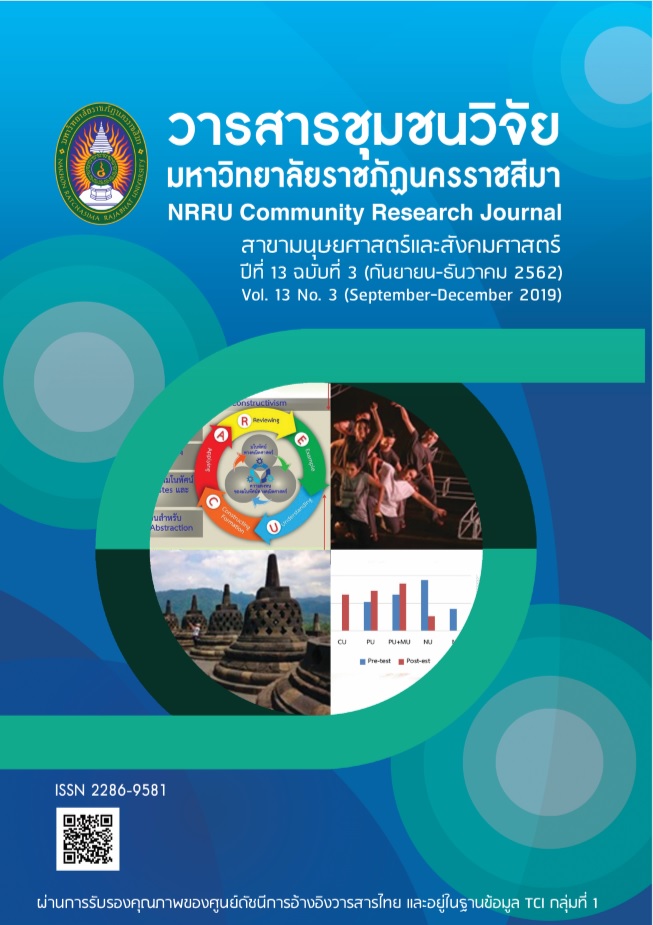A STUDY OF APPLYING FLIPPED CLASSROOM TO IMPROVE COLLABORATIVE PROBLEM SOLVING COMPETENCY AMONG HIGH SCHOOL CHEMISTRY STUDENTS IN THE TOPIC OF STOICHIOMETRY
DOI:
https://doi.org/10.14456/nrru-rdi.2019.54Keywords:
Flipped classroom approach, Collaborative problem solving (CPS) competency, Case study, StoichiometryAbstract
This research studies A) the flipped classroom approach with case study to enhance students’ Collabolative Problem Solving (CPS) competency and B) the results of employing the studied approach to the students’ CPS competency in the topic of Stoichiometry. The research methodology was classroom action research. The participants were 28 students of 10th grade with purposive sampling. All data was collected by lesson plans included activity sheets, reflective learning management form, CPS behavior observation forms, and CPS test. Qualitative data analysis methods was employed by content analysis and the reliability was verified by triangulation method. The study shows that A) the approach using flipped-classroom with case study to improve students’ CPS competency should include five key steps for in-class activities: 1) Reviewing Problems: teacher presents a problem and ask students questions to ensure their understandings, and then encourage them to explore relevant knowledge around the problem, 2) Analyzing Problems: teacher encourages each group to identify specific problems to be solved, 3) Creating Solutions: each group find various solutions to the problem, listing their advantages, disadvantages and limitations, 4) Making Decisions: students in group justify their best solution considering the similarities and differences among the solutions and plan to take actions following the chosen solution, 5) Reflect on Results: each group presents the results, exchange ideas and suggestions to improve the solutions, and their teamwork, B) students mostly developed the CPS competency of establishing and maintaining group organization, establishing and maintaining shared understanding and selecting an appropriate action to solve the problem, respectively.
References
Care, E., Griffin, P., & McGaw, B. (2012). Assessment and teaching of 21st century skills. Springer.
Centre for the New Economy and Society. (2018). The Future of Jobs Report 2018. World Economic Forum 2018. Retrieved May 15, 2017, from http://www3.weforum.org/docs/ WEF_Future_of_Jobs_2018.pdf (In Thai)
Chatsupakul, K. (2003). Group Activities in School. Bangkok: Thanathud printing. (In Thai)
Choi, I., & Lee, K. (2009). Designing and implementing a case-based learning environment for enhancing ill-structured problem solving: Classroom management problems for prospective teachers. Educational Technology Research and Development, 57(1), 99-129.
Cholsin, J. (2016). The action research for developing learning management on stoichiometry based on stem approach emphasized engineering design process to promote collaborative problem solving competency. Journal of Education Naresuan University, 20(2), 32-46. (In Thai)
Ge, X., & Land, S. M. (2003). Scaffolding students’ problem-solving processes in an ill-structured task using question prompts and peer interactions. Educational Technology Research and Development, 51(1), 21-38.
Grypp, L., & Luebeck, J. (2015). Rotating solids and flipping instruction. Mathematics Teacher, 109(3), 186-193.
Hayat, A. Z., & Wahyu, W. (2018). Comparison of peer-tutoring learning model through problem-solving approach and traditional learning model on the cognitive ability of grade 10 students at SMKN 13 Bandung on the topic of Stoichiometry. Journal of Physics: Conference Series, 1013(1), 012208. IOP Publishing.
Hesse, F., Care, E., Buder, J., Sassenberg, K., & Griffin, P. (2015). A framework for teachable collaborative problem solving skills. In Assessment and teaching of 21st century skills (pp. 37-56). Springer, Dordrecht.
IPST. (2016). Collaborative Problem Solving : How is PISA measured? FOCUS in PISA. Retrieved May 15, 2017, from https://pisathailand.ipst.ac.th/issue-2018-25/. (In Thai)
Jantarakantee, E. (2016) Instruction for Promoting Argumentation Skill in Science Classroom. Journal of Yala Rajabhat University, 11(1), 217-232. (In Thai)
Kijkuakul, S. (2014). Scientific learning management: The guide for teachers in 21st century. Petchaboon : Chunladit printing Press. (In Thai)
Lo, C. K., Lie, C. W., & Hew, K. F. (2018). Applying “First principles of instruction” as a design theory of the flipped classroom: Findings from a collective study of four secondary school subjects. Computers & Education, 118, 150-165.
Moraros, J., Islam, A., Yu, S., Banow, R., & Schindelka, B. (2015). Flipping for success: Evaluating the effectiveness of a novel teaching approach in a graduate level setting. BMC Medical Education, 15(1).
OECD. (2013). Draft collaborative problem solving framework. Paris : OECD.
_______. (2017). PISA 2015 COLLABORATIVE PROBLEM-SOLVING FRAMEWORK. Paris : OECD.
Petrillo, J. (2016). On flipping first-semester calculus: a case study. International Journal of Mathematical Education in Science and Technology, 47(4), 573-582.
Rahman, A. A., Aris, B., Rosli, M. S., Mohamed, H., Abdullah, Z., & Mohd Zaid, N. (2015).
Significance of Preparedness in flipped classroom. Advanced Science Letters, 21(10), 3388–3390.
Schleicher, A. (2017). Are school systems ready to develop students’ social skills?. Retrieved May 15, 2017, from http://oecdeducationtoday.blogspot.com/2017/11/are-school-systems-ready-to-develop.html
Srivirojn, W. (2014). The Development of Instructional Model in Stoichiometry based on Integrated Inquiry Training and Cooperative Learning to Enhance Critical Thinking for Upper Secondary Students in an Enrichment Science Classroom. Journal of Education Naresuan University, 16(3), 1-13. (In Thai)
Sungkapun, S. (2014). Why do you need skills in the 21st century? 21st century skill articles. Doctoral’s thesis, Mahasarakham university. Retrieved May 15, 2017, from https://www. srn2.go.th/attachments/article/145/รวมบทความ.pdf (In Thai)





